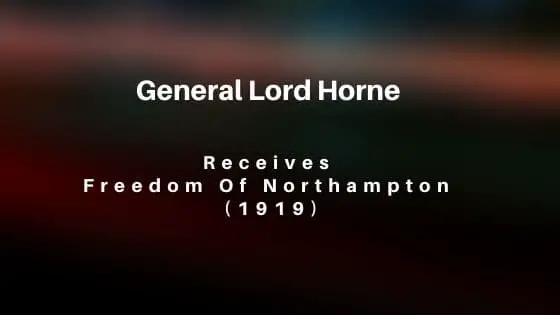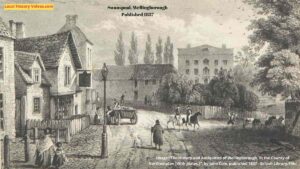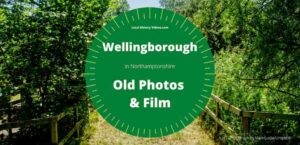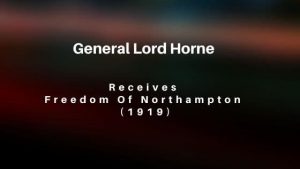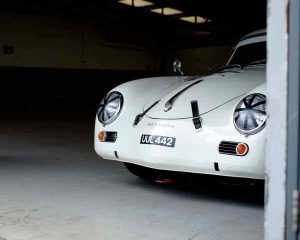In 1919, less than a year after the first world war ended, General Lord Horne received the Freedom of Northampton. Who was Lord Horne, and what was his connection to Northamptonshire?
General Lord Horne In 1919 Film Footage
This is a short and silent film in the British Pathé collection, lasting just 1 minute and 13 seconds long.
We see Lord and Lady Horne arriving in a Rolls Royce. They participate in a civic ceremony with the Freemen of Northampton, including the Mayor or Northampton. Everyone is dressed in all their finery.
Crowds of local people gather to watch the occasion. Perhaps the presence of cars and a filmmaker were just as much a draw as the collection of well dressed local dignitaries?
Thanking Northampton’s WW1 Bootmakers
The full title of the short film is: “Northampton — General Lord Horne — after receiving the Freedom of the City thanks the town for keeping army so well supplied with boots.”
Northampton is famous for its shoe production. Starting back in the 15th century, the shoe industry grew rapidly in the early Victorian age. The British Footwear Association (BFA), which has represented the industry for 120 years, is based in Northamptonshire.
It hasn’t been plain sailing in a modern, globalised world. Anyone who watched the 2005 film ‘Kinky Boots’ saw the impact of cheap imports on Northampton’s quality shoe factories. Even the new niche footwear was not enough to safeguard the factory’s future.
Back in the first world war, then known as the Great War, it was a different story.
People rarely had access to imported goods anyway and sea supplies were now heavily restricted because of enemy action. The first successful airplane was built in the US by Wilbur and Orville Wright on December 17, 1903. Whilst air raids took place in the first world war, air freight was rarely an option. What Britain needed, Britain had to produce.
Meanwhile, five million British men and thousands of soldiers from the British Empire had to be clothed, fed, armed and trained. An essential part of a soldier’s uniform is a quality pair of boots.
Bootmakers in Northampton made 70% of all boots used by the British Army in World War One.
Northampton shoemakers Crockett and Jones doubled its output to meet demand. The firm even took the unusual step of employing women in roles traditionally held by men.
Henry Horne of Stirkoke In Scotland
Born on on 19 February 1861, Henry Sinclair Horne was the third child born to Major James Horne and Constance Mary Horne (nee Shewell). They family estate at Stirkoke in the parish of Wick, in Caithness, Scotland had belonged to the Horne family for many generations.
The shell of the house and its estate buildings still exists today. Unfortunately, Stirkoke has been in a ruinous state for decades. It is on the Buildings at Risk register for Scotland and local planners are concerned about its condition.
According to the registry records, The Aberdeen Press and Journal reports that local farmer Alexander Sinclair purchased Stirkoke in 1965 and does not wish to sell. Because the abandoned and fire damaged house is in the middle of a working farm, inspection visits are rare. However, the building is known to have lost its roof, windows and doors, been severely damaged by fire, and retains just the husk of the outside walls.
Horne was sent away for education at the top British public school of Harrow, near London. He then trained at the Royal Military Academy, Woolwich, before joining the British Army.
Henry Horne In Northamptonshire Before The Great War
Henry Horne served in the British Army between 1880 and 1923. Taking part in the Second Boer War (in South Africa) and the Great War (later known as the First World War), he was parted from his family for long periods of time.
Henry Horne was away at the Boer War in 1901. The national Census of 1901 records his wife Kate, daughters Dorothy and Kate, and seven female servants living at 21 Main Street, East Haddon, Northamptonshire.
He was made lieutenant in the Royal Field Artillery in May 1880, captain on 17 August 1888, major on 23 February 1898, and lieutenant colonel on 29 November 1900. In 1912 he was promoted to brigadier and appointed Inspector of Artillery.
Henry Horne During World War 1
The patronage of Sir Douglas Haig and Sir William Robertson was to help him become an important leader during the Great War.
In October 1914, following action in battle including at Mons, Henry Horne was promoted to Major-General of the Second Division and soon became the only British artillery officer to command an army in the Great War.
Henry Horne in charge assisted Lord Kitchener in the evacuation of Gallipoli in November 1915, before leading the XV Corps troops in the defence of the Suez Canal.
In March 1916, Horne was back on the Western Front leading the First Army for the Battle of the Somme which occurred over the course of the summer. On just one day, 1 July 1916, the British Army suffered 57,740 (casualties including 20,000 fatalities), of which 7,500 casualties were underHorne’s command.
The casualty rates raised allegations about Horne’s decision-making abilities. In addition, General Haig rebuked both Horne and Sir Charles Munro after discovering that their troops were occupying trenches filled with water to the hips.
Despite failings in an era of complexity and uncertainty, he was soon appointed as a temporary General.
In January 1917 he received a further promotion to Lieutenant-General. Unfortunately another military disaster soon occurred for which a French officer was sacked.
Later, his troops took part in notable conflicts helping end the conflict. These include Hill70, the Battle of Arras and the capture of the Vimy Ridge, as well as the Hundred Days Offensive.
Lord Horne After The End Of World War 1
Following the end of the Great War, Horne received the following awards and rewards:
- Made Knight Commander Order of St Michael and St George (KCMG) in 1918
- Made Knight Grand Cross Order of the Bath (G.C.B) in 1919.
- Received thanks of Parliament
- raised to the peerage as Baron Horne, of Stirkoke in the County of Caithness
- Given a grant of 30,000
- promoted to head of the Eastern Command in 1919
- Received Freedom of Northampton in 1919
- appointed a deputy lieutenant of Caithness on 30 July 1920
- appointed Master Gunner of the Artillery, St. James’s Park, 1926
- Governor and Commander of the Church Lads’ Brigade
- appointed Colonel of the Highland Light Infantry, 1929
Today the Generals of the first world war are judged very severely because of the scale of butchery that cut down Britain’s young men in large numbers, particularly in the trenches. Lord Horne spent much of his retirement attending the official establishment of War Memorials, including the Burton Latimer War Memorial. Consequently, he would have been very aware of the scale of loss and its impact on the grieving communities.
Lord Horne Died In Scotland
Throughout most of Lord Horne’s military career, his family appear to have lived in Northamptonshire. He was still living in East Haddon following the Great War.
General Lord Horne officially opened a new club for Northampton’s town veterans in 1920. At the time 47 Sheep Street was known as Kerr House, since it had been the home of physician and co-founder of Northampton General Hospital, Dr Kerr. The Northampton Independent’s editor Mr Holloway set up the Kerr House Trust and spent a year fundraising to fund the purchase of the property and its establishment as a venue to welcome and support veterans. The charity still exists today.
Between 2.40 p.m. and 3.45 p.m on November 17th 1920, the boys attending East Haddon primary school enjoyed a game of football on the Village Club’s Field, having received permission from Lord Horne to do so.
On 14 August 1929, aged 68, Henry Horne, 1st Baron Horne, died suddenly of unknown causes while shooting grouse in his Stirkoke estate at Wick, Caithness, Scotland. He was laid to rest in the family plot at Wick Cemetery.
His obituary appeared in The Times on 15 August 1929.
No Male Heir
Because Horne had daughters Dorothy and Kate (known as Kitten) and later grand-daughters, he died without a male heir.
Consequently, Lord Horne’s title died with him. He had been aware of this situation and tried, unsuccessfully, to invoke legal exceptions which would have allowed the title to pass through his female descendants.
Bear in mind that universal suffrage (the right to vote in elections) was given equally to British men and women over the age of 21, without property bar, just 13 months before his death. Before that, the only women who could vote were those who met minimum property requirements and were past the age of 30.
Lord Horne’s Papers
Horne married Kate McCorquodale, the daughter of George McCorquodale of Newton-le-Willows, Lancashire, in 1897. Every day throughout the Great War, Horne wrote a letter to his wife back at home in Northamptonshire. He also kept his letters and diaries.
His granddaughters later received all of these documents, ultimately donating them to the Imperial War Museum in London.
Further Reading
- Simon Robbins, The First World War Letters of General Lord Horne, 2009
More Pictures of Old Northampton
Old Northampton in Northamptonshire, England, enjoyed through historic photos, vintage pictures & archive film. Browse history in these fascinating old images of a bygone era on my Pinterest board at:
https://www.pinterest.co.uk/LocalHistoryVideos/northampton-old-photos-pictures
More about Northamptonshire
- Old Images of NorthamptonshireGlimpse history through old images of Northamptonshire, England.
- Old Images of Wellingborough, NorthantsGlimpse history through old images of Wellingborough, Northamptonshire, England.
- Lord Horne & Freedom Of Northampton (1919)In 1919, less than a year after the first world war ended, General Lord Horne received the Freedom of Northampton. Who was Lord Horne, and what was his connection to Northamptonshire? General Lord Horne In 1919 Film Footage This is a short and silent film in the British Pathé collection, lasting just 1 minute and… Read more: Lord Horne & Freedom Of Northampton (1919)
- Northamptonshire: Local History VideosNorthamptonshire is in the region called the East Midlands, though many people mistakenly think it is in the West Midlands.
.
Back to Northamptonshire page
Back to Local History Videos home page

